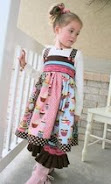 Your Fabric Place
Your Fabric Place I fell in love with this pattern when a friend was carrying the one she made. If I could have stolen it, I would have!Since she would not give me hers, I made my own and am sharing what I learned with you!
I fell in love with this pattern when a friend was carrying the one she made. If I could have stolen it, I would have!Since she would not give me hers, I made my own and am sharing what I learned with you! Enter to Win a Grids & Grommets sewing pattern by Indygo Junction!
Contest details at the end of this page.
 The first step to creating your own Grid & Grommets bag is deciding which size and style option suits you. I chose the large, strip bag version. Sewing is my art form. I Pick fabrics which reflect my mood & personal style. You can see from this picture which fabrics I decided on. All of these strips are from Amy Butler's Daisy Chain Collection.
The first step to creating your own Grid & Grommets bag is deciding which size and style option suits you. I chose the large, strip bag version. Sewing is my art form. I Pick fabrics which reflect my mood & personal style. You can see from this picture which fabrics I decided on. All of these strips are from Amy Butler's Daisy Chain Collection.  The AccuQuilt Go fabric cutter made the task of cutting the 2 1/2 inch strips a quick process, but you could use your rotary cutter & mat method if you don't own a AccuQuilt Go. Either method, will produce a fun and practical use of scraps.
The AccuQuilt Go fabric cutter made the task of cutting the 2 1/2 inch strips a quick process, but you could use your rotary cutter & mat method if you don't own a AccuQuilt Go. Either method, will produce a fun and practical use of scraps.
What I've learned about the Indygo Junction Grids and Grommets purse pattern:
Definition of Practice Run according to Glenna's sewing dictionary; 1: goof-up, 2: mistakes in sewing usually caused by not following directions of the Pattern Designer
___________________________________________________________________
The pattern does not call for interfacing in the top panel (where the grommets are attached). Trust me.......there is a reason for not adding interfacing to the top band. Only the main portion of the Grommet bag is interfaced with fusible fleece.
When I made my practice run bag, I used the same fusible fleece to interface the top panel. All looked well until it was time to attach the grommets. Because of the extra thickness, I could not sandwich the front and back of the curtain grommets into place. Learn from my mistake.....don't use fusible fleece in the top band.Note added on Sept 9,2009:
I now use a heavy stabilizer interfacing in the top band. I fuse it to the exterior band fabric. The heavy fusible interfacing has stability without the thickness of the fusible fleece. I have no problem attaching the grommets
thru the interfaced top bands.
Once your bag is sewn and pressed well, baste the lining of the top band to the exterior top band. This simple step is important in assuring the lining hangs pretty inside your bag.
Yes, you could press and pin the lining in place, however basting is more secure. We want the lining fabric to stay in perfect position when we marking and cutting the holes for the grommets.
Remove the basting threads after your bag is finished.  The grommets are extremely easy to "install" through two layers of fabric (no tools required) Dritz includes a template which makes measuring and marking a breeze and is actually quite fun. Let's not forget the Wow factor something as GRAND as this creates! Thanks Indygo Junction for giving us this Wow factor pattern!!
The grommets are extremely easy to "install" through two layers of fabric (no tools required) Dritz includes a template which makes measuring and marking a breeze and is actually quite fun. Let's not forget the Wow factor something as GRAND as this creates! Thanks Indygo Junction for giving us this Wow factor pattern!! Once you've traced the circle for the cut-out, machine stitch to reinforce. The Grommet will cover your reinforcing stitches. Stitching to reinforce is not mentioned on instructions.
Once you've traced the circle for the cut-out, machine stitch to reinforce. The Grommet will cover your reinforcing stitches. Stitching to reinforce is not mentioned on instructions.
I also ran a thin beading of Fray Check around my marking line to prevent fraying. Once my bead of Fray Check was dry, I cut out the hole. This bag is large enough to load down with books, toys, etc. Taking steps to reinforce the grommet holes is (in my opinion) a good idea.  The large version of the Grids and Grommets bag is wonderful for multi tasking! . It is a purse which could multi task as a diaper, shopping, or even a book bag, yet it looks stylish for an everyday bag.
The large version of the Grids and Grommets bag is wonderful for multi tasking! . It is a purse which could multi task as a diaper, shopping, or even a book bag, yet it looks stylish for an everyday bag.  The final photo shows the straps pulled through to allow extra length for wearing slung across your chest. Great option when we need two free hands and a secure purse!
The final photo shows the straps pulled through to allow extra length for wearing slung across your chest. Great option when we need two free hands and a secure purse!












































